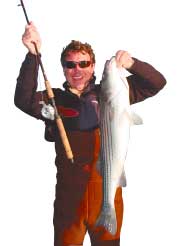
Ever passed by a boat ramp during an unseasonably warm winter day and seen several boat trailers in the parking lot? Did you think the owners were joy riding to awaken a winterized boat? Maybe, maybe not? But anglers don’t have to wait until spring to be able to find some hot action. I love to fish during winter during those warm days.
Those days can offer some of the most rewarding trips of the year. Boat ramps usually are vacant of water skiers and jet skiers and anglers won’t have to wait to launch.
Better yet, water temperatures generally restrict fish to certain regions and reduce search time for anglers. And warm days heat up shallow, protected areas, which attract baitfish and their prey.
Occasionally during winter, the jet stream will develop a southern trough with a northerly flow and will draw warm, moist air from the Gulf of Mexico to the Carolinas. The unseasonable warm air usually is accompanied by a frontal system with rain. Incidentally the barometric pressure will fall and solar-exposed shallow waters will heat up to a relatively warm temperature.
Baitfish and crustaceans will travel into these solar exposed areas. Just before fronts arrive with a falling pressure, fish will respond and feed for a short period at warm regions.
Warming water raises their core body temperature and increases their metabolic rate and their need to replenish food stores. More simply put, the bite “turns on” for a little while.
Since fish are cold blooded creatures, they rely on the external environment to transfer heat into their bodies. A fish’s core body temperature will be near the temperature of the surrounding water.
Inland species that don’t migrate to the ocean practically will go dormant during extended periods of cold weather. In cool waters, fish don’t need to feed as they do in the summer months. Fish will covert built-up fat in their body tissue into energy through special autolytic enzymes. Fish have huge amounts of these enzymes just for this reason.
Consequently, they feed aggressively in the fall to build supplemental body mass to provide enough energy to last through the winter. Some of the best fishing is in the fall of the year when the water temperature is beginning to fall a degree or two per week.
Extended periods of cold weather, without frequent warm spells, will deplete stored reserves and kill off a portion of wintering fish species. Different fish species have different tolerances to cold weather.
Fish with larger body masses, generally can survive longer than slender, leaner fishes. For example, redfish will favor better during long periods of cold weather than speckled trout. Redfish are more thickset and more cold tolerant than more slender speckled trout.
Predator and prey fishes independently will congregate at deep water where temperatures are relatively warmer than surface water. During these unseasonably warm periods, baitfish in marine and brackish environments will travel to the surface and into the mouths of solar-exposed coves and bays that are in close proximity to their deep-water winter hangouts.
Predatory fish will follow and sometimes feed aggressively at the surface at bays and at creek mouths.
The edges of the creek channels passing through bays are usually productive locations. Baitfish also have aerial enemies (birds) that can aid anglers in locating hungry predator fish.
Generally, larger fish will be more active than smaller fish because of their ability to tolerate lower temperatures.
Predatory fish, such as land-locked striped bass, bowfin, crappie and catfish and winter flounder, trout, stripers and redfish will respond directly to warm spells.
Saltwater and freshwater techniques can be used together for most of the year and it’s also the case during winter.
Winter flounder adapt to the seasonal changes, hence the name. They move to shallower inshore waters during winter months to feed and to deeper ocean water during the summer. These fish are a major target species for anglers during the winter at solar-exposed areas.
Striped bass, a cold-water species, migrate from the north to inshore areas to feed during the winter. Stripers feed aggressively throughout the winter preparing for their annual spring spawning run into coastal rivers.
They’ll feed at the mouths of tidal flats where they meet the deep waters, especially during outgoing tides. During outflows, bait that’s accumulated at the warm bars will be towed with the current into eddys and be vulnerable to the choppers of hungry striped bass.
The best lure choices for winter inshore fishing are usually capable of suspension and can be worked slowly throughout the upper water column. Because water will be relatively cool, baitfish won’t be as agile as they would be during spring.
I like to creep close to surfacing baitfish and “match the hatch” or use lures that are generally the same size as the baitfish. A slow presentation will be the key to success.
If available, live bait — free-lined or suspended behind a float — can be productive.
Sun-exposed shallow bars near deep water can be excellent spots to try this technique. Soft and hard structure near the surface in these areas will provide baitfish with cover and also can be hot spots.
Pay close attention to weekly weather forecasts and look for southern troughs and falling barometric pressure that will result in a warm front with warm temperatures.
However, winter fishing can pose health risks. The weather can change suddenly.
Watch out for northern arctic blasts that counter the warm flow from the Gulf and convert a perfect fishing day into a nasty winter storm, bringing unwanted accumulations of ice and snow.
Even coastal areas of South Carolina can experience such weather. These northern blasts of air often ruin a perfectly good fishing day.
But if the warm weather is coming, break out the fishing rods, uncover the boat and go fishing. You don’t have to wait until spring arrives to get into some hot action at the S.C. coast.




Be the first to comment